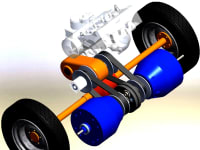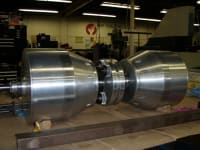As long as kinetic energy recovery systems don’t supplant friction braking and discrete gear reduction levels haven’t been replaced with infinitely, or continuously variable transmissions, automobiles, trucks, and buses will continue to rely on reciprocating piston internal combustion engines and/or electric traction motors.
Technology exists for major step improvements in the thermal efficiency of fossil fuel engines. Advances made in micro-turbine power plants have made possible low-cost, high efficiency, and very high power-to-weight ratios. Companies such as Capstone Turbine Corporation, Williams International, and several others are producing these power sources electric power generation, light aviation, and rail and bus applications.
In 1976, Allison developed a gas-turbine 150kW power unit for the U.S. Army Patriot Missile System. The initial evaluation reported:
Fuel consumption was reduced from 48 to 16 gallons per hour as compared with previous generators.
Free-shaft starting to minus 50 F was accomplished without heaters.
Multi-fuel capability was demonstrated on diesel, JP and gasoline.
All reliability requirements were met.
Sound level standards of less than 90 dBA were met
Previous efforts to utilize a gas turbine power plant in an automobile have not been successful for many reasons, but a major flaw is the inability of a turbine to rapidly accelerate a vehicle. Other challenges include the relatively high RPM’s of a turbine versus the comparably low RPM’s of a typical driveline necessitating high levels of gear reduction.
A KERS system called GraMar, is under development that incorporates two variable- inertia flywheels. This system will capture the kinetic energy of a vehicle and reuse it to accelerate the vehicle. The rate of acceleration or deceleration is determined by the torque capacity of the driveline elements. It operates on a principle similar to a split-path CVT.
An advanced embodiment is the integration of the GraMar system with a complete high-efficiency driveline system that includes a prime mover (ICE, turbine, electric drive) selected for a power source that is constant angular velocity, low torque, and maximum efficiency. This power source will provide only energy to overcome rolling friction, air drag, and driveline friction. In other words, all accelerating power is provided by the GraMar System and all decelerating power (braking) is stored by the GraMar System. In order to accomplish this, the prime mover must be coupled to the GraMar differential through a continuously-variable transmission means (e.g. NuVinci ), but consider that the comparatively high torque required to accelerate is provided directly by the GraMar KERS system and not transferred through the CVT’s.
The same benefits apply to electric traction drives, where the motor sizing and maximum current supplied by the batteries are minimized, thus increasing the range.
Like this entry?
-
About the Entrant
- Name:James Gramling
- Type of entry:individual
- Patent status:patented








